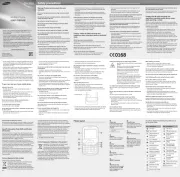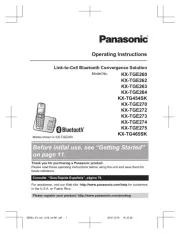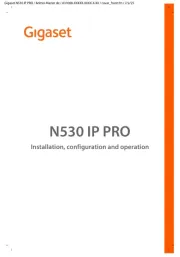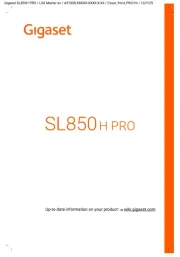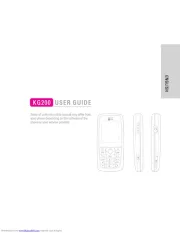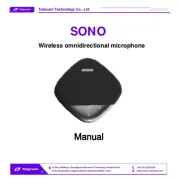
Your phone displays the following status indicators on
Some of the contents in this manual may differ from your •
phone depending on the software of the phone or your
Visit the Samsung website to view the Samsung Mobile •
function guide in Adobe Acrobat (.pdf) format. The function
guide contains common topics about applications and
features that appear in many different models of Samsung
This product includes certain free/open source software.The •
exact terms of the licenses, disclaimers, acknowledgements
and notices are available on the Samsung's website
http://opensource.samsung.com.
To prevent injury to yourself and others or damage to your device, read all of the following information before using your device.
In ldle mode, adjust the key
"Activate and send an SOS
Perform actions indicated at
the bottom of the display
Make or answer a call; In Idle
mode, retrieve recently dialled,
missed, or received numbers
In Idle mode, switch between
SIM cards; Access the SIM
Turn the phone on and off
(press and hold); End a call; In
Menu mode, cancel input and
Scroll through menu options
(drag); In Idle mode, access
Menu mode (press); In Menu
mode, select the highlighted
Electronic devices in a motor vehicle may malfunction due to
the radio frequency of your device
Electronic devices in your car may malfunction due to radio frequency
of your device. Contact the manufacturer for more information.
Comply with all safety warnings and
regulations regarding mobile device usage
while operating a vehicle
While driving, safely operating the vehicle is your rst responsibility.
Never use your mobile device while driving, if it is prohibited by law. For
your safety and the safety of others, practice good common sense and
remember the following tips:
Use a hands-free device.•
Get to know your device and its convenience features, such as •
speed dial and redial. These features help you reduce the time
needed to place or receive calls on your mobile device.
Position your device within easy reach. Be able to access your •
wireless device without removing your eyes from the road. If you
receive an incoming call at an inconvenient time, let your voice mail
Let the person you are speaking with know you are driving. Suspend •
calls in heavy trafc or hazardous weather conditions. Rain, sleet,
snow, ice, and heavy trafc can be hazardous.
Do not take notes or look up phone numbers. Jotting down a “to do” •
list or ipping through your address book takes attention away from
your primary responsibility of driving safely.
Dial sensibly and assess the trafc. Place calls when you are not •
moving or before pulling into trafc. Try to plan calls when your
car will be stationary. If you need to make a call, dial only a few
numbers, check the road and your mirrors, then continue.
Warning: Prevent electric shock, re, and
Do not use damaged power cords or plugs, or loose electrical
Do not touch the power cord with wet hands, or disconnect the
charger by pulling on the cord
Do not bend or damage the power cord
Do not use your device while charging or touch your device
Do not short-circuit the charger or the battery
Do not drop or cause an impact to the charger or the battery
Do not charge the battery with chargers that are not approved
Do not use your device during a thunderstorm
Your device may malfunction and your risk of electric shock is increased.
Do not handle a damaged or leaking Lithium Ion (Li-Ion) battery
For safe disposal of your Li-Ion batteries, contact your nearest
authorised service centre.
Handle and dispose of batteries and chargers with care
Use only Samsung-approved batteries and chargers specically •
designed for your device. Incompatible batteries and chargers can
cause serious injuries or damage to your device.
Never dispose of batteries or devices in a re. Follow all local •
regulations when disposing of used batteries or devices.
Never place batteries or devices on or in heating devices, such as •
microwave ovens, stoves, or radiators. Batteries may explode when
Never crush or puncture the battery. Avoid exposing the battery to •
high external pressure, which can lead to an internal short circuit and
Protect the device, batteries, and chargers from damage
Avoid exposing your device and batteries to very cold or very hot •
Extreme temperatures can cause the deformation of the device and •
reduce the charging capacity and life of your device and batteries.
Prevent batteries from contacting metal objects, as this can create a •
connection between the + and – terminals of your batteries and lead
to temporary or permanent battery damage.
Never use a damaged charger or battery.•
Caution: Follow all safety warnings and
regulations when using your device in restricted
Turn off your device where prohibited
Comply with all regulations that restrict the use of a mobile device in a
Do not use your device near other electronic devices
Most electronic devices use radio frequency signals. Your device may
interfere with other electronic devices.
Do not use your device near a pacemaker
Avoid using your device within a 15 cm range of a pacemaker if •
possible, as your device can interfere with the pacemaker.
If you must use your device, keep at least 15 cm away from the •
To minimise the possible interference with a pacemaker, use your •
device on the opposite side of your body from the pacemaker.
Do not use your device in a hospital or near medical equipment
that can be interfered with by radio frequency
If you personally use any medical equipment, contact the manufacturer
of the equipment to ensure the safety of your equipment from radio
If you are using a hearing aid, contact the manufacturer for
information about radio interference
Some hearing aids may be interfered with by the radio frequency of
your device. Contact the manufacturer to ensure the safety of your
Turn off the device in potentially explosive environments
Turn off your device in potentially explosive environments instead of •
Always comply with regulations, instructions and signs in potentially •
Do not use your device at refuelling points (service stations), near •
fuels or chemicals, and at blasting areas.
Do not store or carry ammable liquids, gases, or explosive materials •
in the same compartment as the device, its parts, or accessories.
Turn off your device when in an aircraft
Using your device in an aircraft is illegal. Your device may interfere with
the electronic navigation instruments of the aircraft.
Do not engage in stressful or emotional conversations that may be •
distracting. Make people you are talking with aware you are driving
and suspend conversations that have the potential to divert your
Use your device to call for help. Dial a local emergency number in •
the case of re, trafc accident, or medical emergencies.
Use your device to help others in emergencies. If you see an auto •
accident, a crime in progress, or a serious emergency where lives
are in danger, call a local emergency number.
Call roadside assistance or a special, non-emergency assistance •
number when necessary. If you see a broken-down vehicle posing
no serious hazard, a broken trafc signal, a minor trafc accident
where no one appears injured, or a vehicle you know to be stolen,
call roadside assistance or another special, non-emergency number.
Proper care and use of your mobile device
Humidity and all types of liquids may damage device parts or •
When wet, remove the battery without turning on your device. Dry •
your device with a towel and take it to a service centre.
Liquids will change the colour of the label that indicates water •
damage inside the device. Water damage to your device can void
your manufacturer’s warranty.
Do not use or store your device in dusty, dirty areas
Dust can cause your device to malfunction.
Do not store your device on slopes
If your device falls, it can be damaged.
Do not store your device in hot or cold areas. Use your device
Your device can explode if left inside a closed vehicle, as the inside •
temperature can reach up to 80 °C.
Do not expose your device to direct sunlight for extended periods of •
time (such as on the dashboard of a car).
Store the battery at 0 °C to 40 °C.•
Do not store your device with such metal objects as coins, keys
Your device may become deformed or malfunction.•
If the battery terminals are in contact with metal objects, it may cause •
Do not store your device near magnetic elds
Your device may malfunction or the battery may discharge from •
exposure to magnetic elds.
Magnetic stripe cards, including credit cards, phone cards, passbooks, •
and boarding passes, may be damaged by magnetic elds.
Do not use carrying cases or accessories with magnetic closures or •
allow your device to come in contact with magnetic elds for extended
Do not store your device near or in heaters, microwaves, hot
cooking equipment, or high pressure containers
Your device may overheat and cause a re.•
Do not drop your device or cause impacts to your device
The screen of your device may be damaged.•
If bent or deformed, your device may be damaged or parts may •
Do not use a ash close to the eyes of people or animals
Using a ash close to the eyes may cause temporary loss of vision or
Ensure maximum battery and charger life
Avoid charging batteries for more than a week, as overcharging may •
Over time, unused batteries will discharge and must be recharged •
Disconnect chargers from power sources when not in use.•
Use batteries only for their intended purposes.•
Use manufacturer-approved batteries, chargers, accessories
Using generic batteries or chargers may shorten the life of your device •
or cause the device to malfunction.
Samsung cannot be responsible for the user’s safety when using •
accessories or supplies that are not approved by Samsung.
Do not bite or suck on the device or the battery
Doing so may damage the device or cause explosion.•
If children use the device, make sure that they use the device •
When speaking on the device:
Hold the device upright, as you would with a traditional phone.•
Speak directly into the mouthpiece.•
Avoid contact with your device’s internal antenna. Touching the •
antenna may reduce the call quality or cause the device to transmit
more radio frequency than necessary.
Hold the device with a relaxed grip, press the keys lightly, use special •
features that reduce the number of keys you have to press (such as
templates and predictive text), and take frequent breaks.
When cleaning your device:
Wipe your device or charger with a towel or a rubber.•
Clean the terminals of the battery with a cotton ball or a towel.•
Do not use chemicals or detergents.•
Do not use the device if the screen is cracked or broken
Broken glass or acrylic could cause injury to your hands and face. Take
the device to a Samsung Service Centre to have it repaired.
Do not use the device for anything other than its intended use
Avoid disturbing others when using the device in public
Do not allow children to use your device
Your device is not a toy. Do not allow children to play with it as they
could hurt themselves and others, damage the device, or make calls
that increase your charges.
Install mobile devices and equipment with caution
Ensure that any mobile devices or related equipment installed in •
your vehicle are securely mounted.
Avoid placing your device and accessories near or in an air bag •
deployment area. Improperly installed wireless equipment can cause
serious injury when air bags inate rapidly.
Allow only qualied personnel to service your device
Allowing unqualied personnel to service your device may result in
damage to your device and will void your manufacturer’s warranty.
Handle SIM cards or memory cards with care
Do not remove a card while the device is transferring or accessing •
information, as this could result in loss of data and/or damage to the
Protect cards from strong shocks, static electricity, and electrical •
noise from other devices.
Do not touch gold-coloured contacts or terminals with your ngers or •
metal objects. If dirty, wipe the card with a soft cloth.
Protect your hearing and ears when using a headset
Excessive exposure to loud sounds can cause hearing •
Exposure to loud sounds while walking may distract •
your attention and cause an accident.
Always turn the volume down before plugging the •
earphones into an audio source and use only the
minimum volume setting necessary to hear your
In dry environments, static electricity can build up in •
the headset. Avoid using headsets in dry environments
or touch a metal object to discharge static electricity
before connecting a headset to the device.
Do not use a headset while driving or riding. Doing so •
may distract your attention and cause an accident, or
may be illegal depending on your region.
Use caution when using the device while walking or moving
Always be aware of your surroundings to avoid injury to yourself or
Do not carry your device in your back pockets or around your
You can be injured or damage the device if you fall.
Do not disassemble, modify, or repair your device
Any changes or modications to your device can void your •
manufacturer’s warranty. For service, take your device to a Samsung
Do not disassemble or puncture the battery, as this can cause •
Paint can clog moving parts and prevent proper operation. If you are
allergic to the paint or metal parts of the device, stop using the device
and consult your physician.
Ensure access to emergency services
Emergency calls from your device may not be possible in some areas
or circumstances. Before travelling in remote or undeveloped areas,
plan an alternate method of contacting emergency services personnel.
Specic Absorption Rate (SAR) certication
Your device conforms to European Union (EU) standards that limit
human exposure to radio frequency (RF) energy emitted by radio and
telecommunications equipment. These standards prevent the sale of
mobile devices that exceed a maximum exposure level (known as the
Specic Absorption Rate, or SAR) of 2.0 W/kg.
During testing, the maximum SAR recorded for this model was
0.732 W/kg. In normal use, the actual SAR is likely to be much lower,
as the device has been designed to emit only the RF energy necessary
to transmit a signal to the nearest base station. By automatically
emitting lower levels when possible, your device reduces your overall
The Declaration of Conformity statement at the back of this manual
demonstrates your device’s compliance with the European Radio
& Terminal Telecommunications Equipment (R&TTE) directive. For
more information about the SAR and related EU standards, visit the
Correct disposal of this product
(Waste Electrical & Electronic Equipment)
(Applicable in the European Union and other European
countries with separate collection systems)
This marking on the product, accessories or literature
indicates that the product and its electronic accessories
(e.g. charger, headset, USB cable) should not be disposed
of with other household waste at the end of their working
To prevent possible harm to the environment or human health from
uncontrolled waste disposal, please separate these items from other
types of waste and recycle them responsibly to promote the sustainable
reuse of material resources.
Household users should contact either the retailer where they purchased
this product, or their local government ofce, for details of where and
how they can take these items for environmentally safe recycling.
Business users should contact their supplier and check the terms and
conditions of the purchase contract. This product and its electronic
accessories should not be mixed with other commercial wastes for
This EEE is compliant with RoHS.
Correct disposal of batteries in this product
(Applicable in the European Union and other European
countries with separate battery return systems)
This marking on the battery, manual or packaging indicates
that the batteries in this product should not be disposed of
with other household waste at the end of their working life.
Where marked, the chemical symbols Hg, Cd or Pb indicate that the
battery contains mercury, cadmium or lead above the reference levels
in EC Directive 2006/66. If batteries are not properly disposed of, these
substances can cause harm to human health or the environment.
To protect natural resources and to promote material reuse, please
separate batteries from other types of waste and recycle them through
your local, free battery return system.
